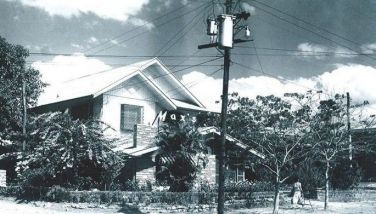Better get your EWD

May 31, 2003 | 12:00am
We’ve almost forgotten what an EWD is. That’s Early Warning Device. if we don’t have it, we’re bound to get into trouble with the Land Transportation Office (LTO) for a traffic violation.
Because of complaints – if not misunderstanding – about the re-imposition of the use of EWDs, Assistant Land Transportation Secretary Roberto T. Lastimoso met with selected members of the press to explain that EWDs are 1) required by law and 2) there is no hanky-panky involved in the selling or pricing of the merchandise.
The installation of EWDs on motor vehicles, except motorcycles and trailers, began with the issuance of the late President Marcos of Letter of Instruction No. 229 dated December 2, 1974. This was in compliance of an international agreement arrived at a UN conference on Road Traffic, Road signs and signals held in Vienna, Austria on 1968, in which the Philippines was a signatory. The agreement was ratified through PD No. 207 dated June 6, 1973.
On Nov. 15, 1976, the third paragraph of LOI 229 was amended, honoring any brand or make of the EWD chosen by the owner. On Dec. 10, 1976, the Department of Transportation and Communication issued Administration Order No. 12 amended the rules and regulations implementing LOI 229.
For some reason, in July 1992, the then secretary of DOTC suspended the imposition of the EWD. On July 12, 1995, however, MC No. 95-219 was issued, re-imposing the requirement for vehicles to carry EWDs.
On March 22, 2002, LTO Assistant Secretary Lastimoso noted that EWDs were not being used. consequently, Memorandum Circular No. RTL-MC-02412, followed by MC Nos. RTL-MC-03434 and RTL-MC-03438, were issued to prescribe guidelines in enforcing the EWD requirement.
The re-imposition was made, said Mr. Lastimoso, "to prevent hazards on the road, obstruction to traffic and accidents caused by non-installation of the EWD or use of inappropriate EWD to signal approaching motorists of their presence."
The hazards posted by such obstruction to traffic have been recognized by international bodies like the 1968 Vienna Convention, he said. "When I issued a memorandum to enforce strictly the installation and use of EWDs, it was merely a reiteration of the law which also honors an international comity, but above all, upholds the policy to promote road safety."
The rules and regulation for the re-imposition were made effective on April 21, 2003. Penalties for violations are the following:
1. For operating a motor vehicle without carrying a pair of EWD, a fine of P100.
2. For failure to install an EWD whenever the motor vehicle is stalled or disabled fine of P300 and suspension of the driver’s license for 30 days.
3. When, upon apprehension of a stalled or disabled motor vehicle for non-installation of EWD, the additional violation of non-carrying EWD is found, payment of the P300 fine (failure to install) and P100 fine (failure to carry), the license of the driver shall be held in abeyance until a pair of EWD is presented during the adjudication of the case.
4. If the vehicle is impounded and among the violations included in the charge sheet is failure to cary a pair of EWD, aside from the payment of the P100 fine, the release of the vehicle shall be held in abeyance until a pair of EWD can be presented.
5. For failure to install EWD and such failure resulted in an accident, the license of the driver shall be suspended for a period not exceeding two years or revoked depending upon the circumstances.
6. Any official or employee of LTO who effected the original or renewal registration of a motor vehicle not equipped with a pair of EWD as required.
The EWDs are manufactured by private dealers who have to follow regulations regarding dimensions and material as set forth by a EWD committee. Stickers bearing the serial numbers that correspond to the serial number of the EWD shall be attached to the EWD and on the windshield of the motor vehicle.
Mr. Lastimoso emphatically says that the LTO is "not engaged in the business of selling EWDs, nor does it have anything to do with pricing of the merchandise." He enjoins the public to report any LTO official or personnel making brisk business out of the merchandise so appropriate administrative or criminal action is filed against him/her.
On another front, a lot of women will fondly remember the La Protection de la Infancia, Inc., which was famous for its Gota de Leche program that provided milk and other provisions for infants and mothers. The Gota de Leche building, which stood at Sergio H. Loyola St. (Formerly Lepanto St.,), Sampaloc, Manila on a property donated by philanthropist Teodoro Yangco, was newly restored and inaugurated recently. the ceremonies marked the unveiling of a historical marker for the architectural landmark presented by the National Historical Institute.
Guest of honor at the inaugural program was Secretary Teresita Quintos-Delos, director-general of the National Anti-Poverty Commission, who spoke of her childhood memories at Gota de Leche and of the importance of the architectural landmark in our lives today.
The program was hosted by Boots Anson-Roa and guests included Maribel Ongpin, Emelita Almosara of the National Historical Institute, and members of the Heritage Society led by Architect Augusto F. Villalon. Cocoy Laurel and Francis Magalona entertained the guests with song numbers.
The original building was designed by Architect Arcadio Arellano in 1915 while the restoration was designed by the renowned conservationist Architect Villalon, with colors of the building interiors designed by Tats Manahan. Landscaping was done by Ani Karina S. de Leon of Lupon Inc.
La Protection de la Infancia Inc. is one of the oldest organizations in the country promoting the welfare of needy infants and mothers. among its founding directors were the foremost women of the early 19th century, including Trinidad Rizal, Aurora A. Quezon, Concepcion Felix, Trinidad H. Pardo de Tavera and Natividad Almeda-Lopez.
Because of complaints – if not misunderstanding – about the re-imposition of the use of EWDs, Assistant Land Transportation Secretary Roberto T. Lastimoso met with selected members of the press to explain that EWDs are 1) required by law and 2) there is no hanky-panky involved in the selling or pricing of the merchandise.
On Nov. 15, 1976, the third paragraph of LOI 229 was amended, honoring any brand or make of the EWD chosen by the owner. On Dec. 10, 1976, the Department of Transportation and Communication issued Administration Order No. 12 amended the rules and regulations implementing LOI 229.
On March 22, 2002, LTO Assistant Secretary Lastimoso noted that EWDs were not being used. consequently, Memorandum Circular No. RTL-MC-02412, followed by MC Nos. RTL-MC-03434 and RTL-MC-03438, were issued to prescribe guidelines in enforcing the EWD requirement.
The hazards posted by such obstruction to traffic have been recognized by international bodies like the 1968 Vienna Convention, he said. "When I issued a memorandum to enforce strictly the installation and use of EWDs, it was merely a reiteration of the law which also honors an international comity, but above all, upholds the policy to promote road safety."
1. For operating a motor vehicle without carrying a pair of EWD, a fine of P100.
2. For failure to install an EWD whenever the motor vehicle is stalled or disabled fine of P300 and suspension of the driver’s license for 30 days.
3. When, upon apprehension of a stalled or disabled motor vehicle for non-installation of EWD, the additional violation of non-carrying EWD is found, payment of the P300 fine (failure to install) and P100 fine (failure to carry), the license of the driver shall be held in abeyance until a pair of EWD is presented during the adjudication of the case.
4. If the vehicle is impounded and among the violations included in the charge sheet is failure to cary a pair of EWD, aside from the payment of the P100 fine, the release of the vehicle shall be held in abeyance until a pair of EWD can be presented.
5. For failure to install EWD and such failure resulted in an accident, the license of the driver shall be suspended for a period not exceeding two years or revoked depending upon the circumstances.
6. Any official or employee of LTO who effected the original or renewal registration of a motor vehicle not equipped with a pair of EWD as required.
The EWDs are manufactured by private dealers who have to follow regulations regarding dimensions and material as set forth by a EWD committee. Stickers bearing the serial numbers that correspond to the serial number of the EWD shall be attached to the EWD and on the windshield of the motor vehicle.
Mr. Lastimoso emphatically says that the LTO is "not engaged in the business of selling EWDs, nor does it have anything to do with pricing of the merchandise." He enjoins the public to report any LTO official or personnel making brisk business out of the merchandise so appropriate administrative or criminal action is filed against him/her.
Guest of honor at the inaugural program was Secretary Teresita Quintos-Delos, director-general of the National Anti-Poverty Commission, who spoke of her childhood memories at Gota de Leche and of the importance of the architectural landmark in our lives today.
The program was hosted by Boots Anson-Roa and guests included Maribel Ongpin, Emelita Almosara of the National Historical Institute, and members of the Heritage Society led by Architect Augusto F. Villalon. Cocoy Laurel and Francis Magalona entertained the guests with song numbers.
La Protection de la Infancia Inc. is one of the oldest organizations in the country promoting the welfare of needy infants and mothers. among its founding directors were the foremost women of the early 19th century, including Trinidad Rizal, Aurora A. Quezon, Concepcion Felix, Trinidad H. Pardo de Tavera and Natividad Almeda-Lopez.
BrandSpace Articles
<
>
- Latest
- Trending
Trending
Latest
Latest
Recommended

April 16, 2025 - 12:00am

April 13, 2025 - 12:00am


























